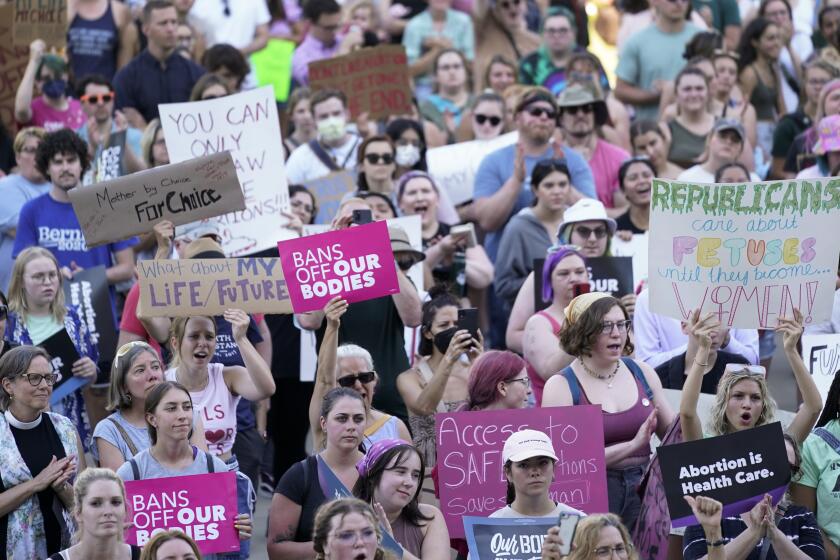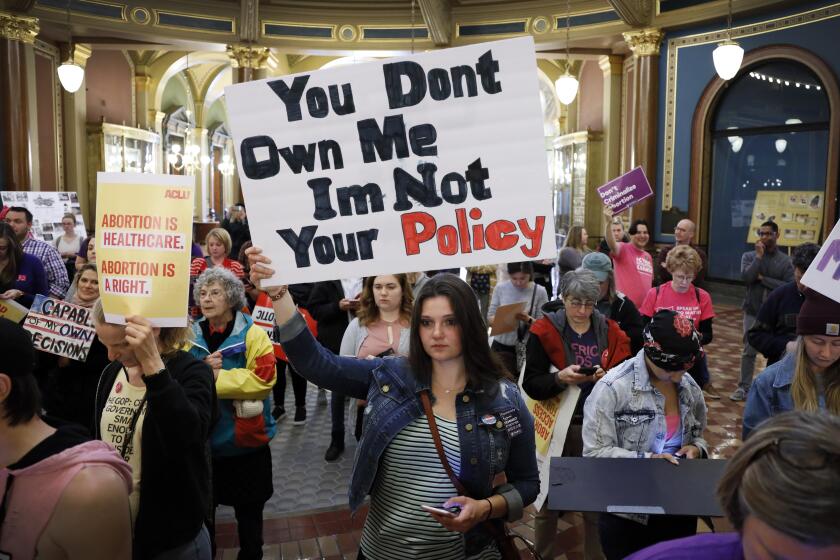The post-Roe strategy: Elect more abortion access champions

- Share via
This year, instead of celebrating the 50th anniversary of Roe vs. Wade, the landmark Supreme Court ruling guaranteeing a constitutional right to abortion, advocates of reproductive rights are observing the grim one-year mark since the court overturned that ruling — and mapping out strategies for restoring abortion access where it was lost and preserving it where it still exists.
Rarely does the court take away established rights, but that’s what the conservative majority of this Supreme Court did in its ruling in Dobbs vs. Jackson Women’s Health Organization on June 24, 2022, returning reproductive rights to the vagaries of state legislatures.
Today, the country is a shifting patchwork of abortion laws. There are at least 12 states with complete bans in effect. Nearly a dozen others have banned abortions after a certain point in gestation, ranging from six to 18 weeks, though some have been blocked by the courts. Abortion remains legal through most of the first trimester or beyond in about a dozen or so states, including California, Oregon and Washington.
Editorial: A federal judge outlaws an abortion pill that’s safer than Tylenol. This is ridiculous
The ruling ignores good sense, sound medical judgment and more than two decades of safe usage around the world. Mifepristone has been used safely in the U.S. for more than 20 years.
Medical care for pregnant people in many states has been badly affected by the new restrictions. Some doctors and hospitals in states that only allow abortion care in emergency situations are so worried about breaking the law, they have refused to perform abortions until a patient’s health is in serious peril.
Meanwhile, reproductive rights advocates have sued to block some state bans and restrictive laws, arguing that they violate personal protections already in state constitutions. But when courts have agreed to block the laws, state legislators often just retool them. No sooner had the Center for Reproductive Rights won a legal victory in South Carolina striking down a six-week abortion ban than the state Legislature passed another six-week abortion ban. (The center is suing to block that one as well.) It’s like Whac-a-Mole.
Despite the chaos and grim statistics, poll after poll has shown that a majority of Americans support at least some level of abortion access — and that support has only increased, according to a FiveThirtyEight analysis, as people have had to confront the reality of no Roe-era protections.
Indeed, voters seem increasingly serious about making their elected officials support abortion access. In liberal and conservative states, voters have demonstrated a striking determination to enshrine the right to abortion in their state’s constitutions, including California and Vermont where abortion protections are already robust. But voters in purple Michigan also approved a constitutional amendment guaranteeing a right to abortion. And in Kansas, Democratic and Republican voters together decisively voted down an amendment that would have stated the constitution did not protect abortion rights.
Voters in five states gave abortion rights a clear victory on election day.
Going into the next year, the best way out of this nearly dystopian world is through the ballot box.
Advocates in a number of states are considering ballot measures amending state constitutions to include a right to abortion, but it’s a challenging path. Some state legislatures are attempting to thwart these efforts by raising the threshold of votes needed to pass a constitutional amendment. In Ohio, where advocates expect to have a constitutional amendment on the ballot this November, the Legislature has set a special election in August to ask voters whether to raise the vote needed for passage of a constitutional amendment from a simple majority to 60%.
Of course, advocates should still work to get state constitutional amendments passed. But the difficulty of that battle makes it clear that voters must wield their power by holding every elected official at every level — particularly state and national levels — accountable. Every candidate for political office should be queried on whether he or she supports abortion access. If they don’t, that should be a deal breaker. Voters must decide that a person’s right to control their own bodies is paramount.
The suspension of a safe and effective medication for chemical abortions may or may not withstand legal challenges. But its real purpose, to create fear and confusion, has been accomplished.
That means not electing or reelecting a member of Congress who won’t support the Women’s Health Protection Act. Abortion access advocates say it’s essential to keep building support for this bill that would codify into law the right to an abortion. It passed the House when it was Democratically controlled but has yet to pass the Senate. President Biden has said he would sign it into law.
And every candidate for Congress or president should be asked if they support repealing the Comstock Act, the outdated 19th century vice law that says materials related to abortion cannot be sent through the mail. Abortion opponents have seized upon it as a tool to fight access. The Office of Legal Counsel of the Justice Department has declared that the law doesn’t prohibit the mailing of drugs if they are not intended for unlawful use, but why let it get brandished by abortion opponents? Let’s get rid of it.
Voters have to do more than tell pollsters they support a right to abortion. They have to use their voting power to show elected officials the door if they won’t support access — and to keep it closed to candidates who won’t promise to protect reproductive rights.
More to Read
A cure for the common opinion
Get thought-provoking perspectives with our weekly newsletter.
You may occasionally receive promotional content from the Los Angeles Times.











